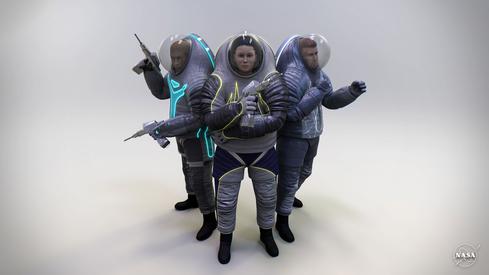Commerce Department Shares R&D Breakthroughs
Federal R&D labs have cranked out a better breathing apparatus for firefighters, and improved climate modeling, among other developments for public use, according to Commerce Department report.


NASA's Next Spacesuit: Mars Fashion
NASA's Next Spacesuit: Mars Fashion (Click image for larger view and slideshow.)
One of many innovations to emerge from the Commerce Department's federal laboratories last year was a new test designed to reduce the potentially lethal failure of faceplate lenses in firefighting equipment. The test, developed by the National Institute of Standards and Technology (NIST), is an example of research and development and technology transfer activities the Department of Commerce (DOC) supports each year to benefit the public. The DOC's latest activities are highlighted in a new report released last week.
The report focuses on three agencies within the Commerce Department that conduct research and development related to science and technology: NIST, the National Oceanic and Atmospheric Administration (NOAA), and the National Telecommunications and Information Administration's (NTIA) Institute for Telecommunication Sciences (ITS).
[Read how NIST developed a new F2 cesium fountain clock that's three times more accurate than the current models: NIST Unveils Super-Accurate Atomic Clock.]
DOC officials are quick to note that technology transfer plays a major role in promoting "job creation, economic growth, sustainable development, and improved standards of living for all Americans."
At NIST, the Technology Transfer Policy Committee is responsible for reaching external partners and transferring technology. The committee identifies commercially valuable inventions that come from NIST's research. NIST provides a variety of application software programs, testing tools, and databases to companies, academia, and others interested in the research.
In addition to developing a rigorous test for firefighter breathing equipment, NIST last year released a Green Button software developer kit user guide for electric utilities to provide customers with tools for accessing their energy usage data. (By clicking a green button on utilities' websites, customers can download their energy usage data.) The user guide, part of the Green Button initiative launched in 2011, offers an overview for utilities not yet using Green Button, and contains sample source code and examples of finished Green Button data sets.
NOAA's technology transfer activities are handled by the Technology Partnerships Office. The agency's technology and innovation enterprise encompasses 50 laboratories, programs, and offices. NOAA is planning to develop a database to easily track and monitor basic information on cooperative research and development agreements, patents, and more. The agency is currently exploring "a number of internal and existing technology transfer database capabilities for hosting the NOAA technology transfer data," says the report.
One example of NOAA's technology transfer efforts is the Coupled Model Intercomparison Project, which compares multiple model simulations to observations and to each other. The comparisons can lead to a better understanding of past and future climate changes, as well as an improved climate model, NOAA said. Such models have produced more than 180 terabytes of data.
ITS, which is the research and engineering arm of NTIA, promotes advanced telecommunications and information infrastructure development in the US. For years ITS has worked with private-sector firms to design, develop, test, and evaluate advanced telecommunication concepts. The agency has established a broadband demonstration network to test emerging LTE broadband equipment for public safety.
DOC's role to coordinate technology transfer activities across federal agencies was expanded by the presidential memorandum issued in October 2011. The memo's purpose was to increase commercialization activities significantly over the next five years. The three labs profiled in the DOC report are taking actions to establish goals and create partnerships to accelerate technology transfer, with the ultimate goal of introducing new products to market.
NIST's cyber-security framework gives critical-infrastructure operators a new tool to assess readiness. But will operators put this voluntary framework to work? Read the Protecting Critical Infrastructure issue of InformationWeek Government today.
About the Author(s)
You May Also Like







